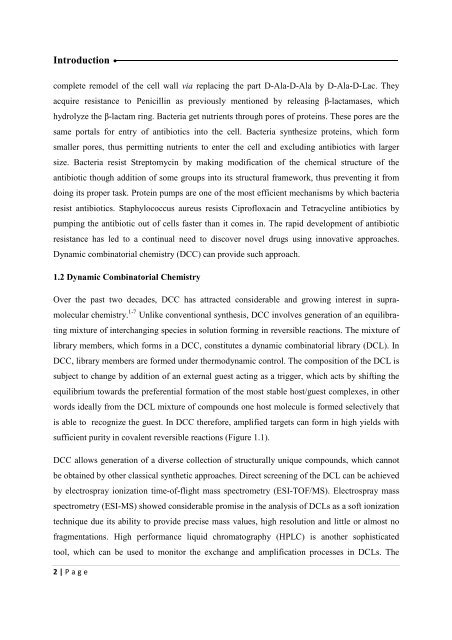The Development of Novel Antibiotics Using ... - Jacobs University
The Development of Novel Antibiotics Using ... - Jacobs University
The Development of Novel Antibiotics Using ... - Jacobs University
You also want an ePaper? Increase the reach of your titles
YUMPU automatically turns print PDFs into web optimized ePapers that Google loves.
Introduction<br />
complete remodel <strong>of</strong> the cell wall via replacing the part D-Ala-D-Ala by D-Ala-D-Lac. <strong>The</strong>y<br />
acquire resistance to Penicillin as previously mentioned by releasing β-lactamases, which<br />
hydrolyze the β-lactam ring. Bacteria get nutrients through pores <strong>of</strong> proteins. <strong>The</strong>se pores are the<br />
same portals for entry <strong>of</strong> antibiotics into the cell. Bacteria synthesize proteins, which form<br />
smaller pores, thus permitting nutrients to enter the cell and excluding antibiotics with larger<br />
size. Bacteria resist Streptomycin by making modification <strong>of</strong> the chemical structure <strong>of</strong> the<br />
antibiotic though addition <strong>of</strong> some groups into its structural framework, thus preventing it from<br />
doing its proper task. Protein pumps are one <strong>of</strong> the most efficient mechanisms by which bacteria<br />
resist antibiotics. Staphylococcus aureus resists Cipr<strong>of</strong>loxacin and Tetracycline antibiotics by<br />
pumping the antibiotic out <strong>of</strong> cells faster than it comes in. <strong>The</strong> rapid development <strong>of</strong> antibiotic<br />
resistance has led to a continual need to discover novel drugs using innovative approaches.<br />
Dynamic combinatorial chemistry (DCC) can provide such approach.<br />
1.2 Dynamic Combinatorial Chemistry<br />
Over the past two decades, DCC has attracted considerable and growing interest in supramolecular<br />
chemistry. 1-7 Unlike conventional synthesis, DCC involves generation <strong>of</strong> an equilibrating<br />
mixture <strong>of</strong> interchanging species in solution forming in reversible reactions. <strong>The</strong> mixture <strong>of</strong><br />
library members, which forms in a DCC, constitutes a dynamic combinatorial library (DCL). In<br />
DCC, library members are formed under thermodynamic control. <strong>The</strong> composition <strong>of</strong> the DCL is<br />
subject to change by addition <strong>of</strong> an external guest acting as a trigger, which acts by shifting the<br />
equilibrium towards the preferential formation <strong>of</strong> the most stable host/guest complexes, in other<br />
words ideally from the DCL mixture <strong>of</strong> compounds one host molecule is formed selectively that<br />
is able to recognize the guest. In DCC therefore, amplified targets can form in high yields with<br />
sufficient purity in covalent reversible reactions (Figure 1.1).<br />
DCC allows generation <strong>of</strong> a diverse collection <strong>of</strong> structurally unique compounds, which cannot<br />
be obtained by other classical synthetic approaches. Direct screening <strong>of</strong> the DCL can be achieved<br />
by electrospray ionization time-<strong>of</strong>-flight mass spectrometry (ESI-TOF/MS). Electrospray mass<br />
spectrometry (ESI-MS) showed considerable promise in the analysis <strong>of</strong> DCLs as a s<strong>of</strong>t ionization<br />
technique due its ability to provide precise mass values, high resolution and little or almost no<br />
fragmentations. High performance liquid chromatography (HPLC) is another sophisticated<br />
tool, which can be used to monitor the exchange and amplification processes in DCLs. <strong>The</strong><br />
2 | P a g e

















